
Roseville is a neighborhood in the city of Newark in Essex County, New Jersey, United States. It borders Bloomfield and East Orange. To the neighborhood's immediate east is the Newark City Subway and Branch Brook Park. Roseville is divided into Upper Roseville north of 3rd Ave and Lower Roseville south of 3rd Ave.
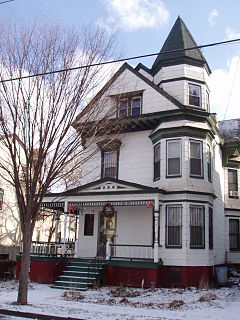
Fairmount is a neighborhood in the city of Newark in Essex County, New Jersey, United States. It is part of the West Ward. Its population is mostly African American. Central Avenue is the major street, though its commerce is considerably reduced from the Industrial Era heyday. The neighborhood is bounded by South Orange Avenue on the south, the Garden State Parkway on the west, Interstate 280 on the north, and the University of Medicine and Dentistry of New Jersey on the east.

The Peoples Church of East Lansing is an interdenominational Protestant congregation located in the city of East Lansing, Michigan. It is officially a member of the American Baptist Churches USA, the Presbyterian Church (U.S.A.), the United Church of Christ, and the United Methodist Church. The congregation's membership currently numbers around 1,300.

The New York Avenue Presbyterian Church in Washington, D.C., is a congregation of the Presbyterian Church (USA). The church was formed in 1859–1860 but traces its roots to 1803 as the F Street Associate Reformed Presbyterian Church and another congregation founded in 1820 on its current site, the Second Presbyterian Church. It is located at the intersection of 13th Street and New York Avenue in the city's northwest quadrant, four blocks from the White House. Due to its proximity to the White House, a number of US presidents have attended services there.
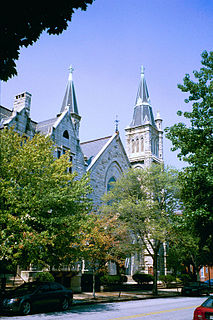
Brown Memorial Park Avenue Presbyterian Church of Baltimore, Maryland, U.S., is a large, Gothic Revival-style church built in 1870 and located at Park Avenue and Lafayette Avenue in the city's Bolton Hill neighborhood. Named in memory of a 19th-century Baltimore financier, the ornate church is noted for its exquisite stained glass windows by renowned artist Louis Comfort Tiffany, soaring vaulted ceiling, and the prominent persons associated with its history. Maltbie Babcock, who was the church's pastor 1887–1900, wrote the familiar hymn, This is My Father's World. Storied virtuoso concert performer Virgil Fox was organist at Brown Memorial early in his career (1936–1946).

Fifth Avenue Presbyterian Church is a Presbyterian Church (U.S.A.) church in New York City. The church, on Fifth Avenue at 7 West 55th Street in Midtown Manhattan, has approximately 2,200 members and is one of the larger PCUSA congregations. The church, founded in 1808 as the Cedar Street Presbyterian Church, has been at this site since 1875.

Makemie Memorial Presbyterian Church is a historic Presbyterian church located in Snow Hill, Worcester County, Maryland.
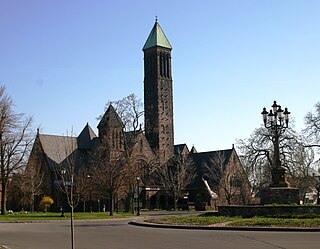
The First Presbyterian Church in Buffalo, New York was the first organized religious body formed in what was then the western frontier of New York State. The town of Buffalo was sparsely populated when the church was organized on February 2, 1812. However, having survived the War of 1812, the town of Buffalo was rebuilt and rapidly grew with the completion of the Erie Canal in 1825. The first two buildings were located on the same downtown lot. However, the congregation relocated between 1889 and 1891 to its present location approximately one and-a-half miles to the north in a more residential area.
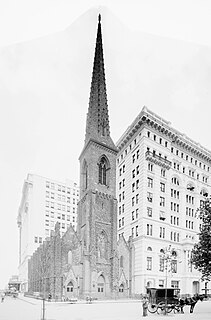
Madison Square Presbyterian Church was a Presbyterian church in Manhattan, New York City, located on Madison Square Park at the southeast corner of East 24th Street and Madison Avenue. Construction on the church began in 1853 and was completed in 1854. It was designed by Richard M. Upjohn, the son of noted architect Richard Upjohn, in the Gothic Revival architectural style. The congregation's original building was acquired by the Metropolitan Life Insurance Company and was demolished in 1909 to make way for the 48-story Metropolitan Life Insurance Company Tower. In exchange, the church received a 75 feet (23 m) by 150 feet (46 m) plot of land across 24th Street that became the site for Stanford White's Madison Square Presbyterian Church.
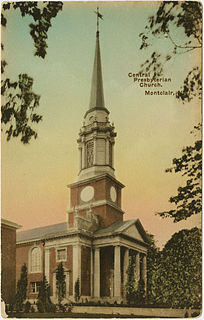
Central Presbyterian Church is an historic church located at 46 Park Street in Montclair, New Jersey, United States.

St. Barnabas' Episcopal Church, is located in Newark, Essex County, New Jersey, United States. The building was built in 1864 and was added to the National Register of Historic Places on October 18, 1972.
West Presbyterian Church was a congregation and two houses of worship in Manhattan, New York City. The congregation was founded in 1829 and merged in 1911 with Park Presbyterian Church to form West-Park Presbyterian Church. The first house of worship, also known as the Carmine Street Presbyterian Church, in Greenwich Village, was used from 1832 to 1865, and the second, on West 42nd Street between Fifth Avenue and Sixth Avenue, from 1865 until 1911, when it was sold and demolished. Proceeds from the sale were used, in accordance with the merger agreement, to build and endow a church for an underserved neighborhood, Washington Heights: Fort Washington Presbyterian Church. In addition, the West Church congregation had earlier established two mission churches which eventually merged to become Good Shepherd-Faith Presbyterian Church. West-Park, Fort Washington, and Good Shepherd-Faith are all active today.
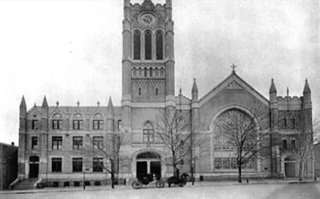
The congregation of North Presbyterian Church, at 525 West 155th Street in Manhattan, New York City, is a combination of three former congregations: North Presbyterian Church, Washington Heights Presbyterian Church, and St. Nicholas Avenue Presbyterian Church.

The Fourth Presbyterian Church of Chicago is one of the largest congregations of the Presbyterian Church (U.S.A.), located in the Magnificent Mile neighborhood of Chicago, directly across Michigan Avenue from the John Hancock Center.

First Presbyterian Church is located in Marion, Iowa, United States. It was listed on the National Register of Historic Places in 1992.

Calvary Memorial Church of Oak Park is a nondenominational church on Lake Street in Oak Park, Illinois, United States.

Bay Ridge United Church (BRUC) was located on Bay Ridge Parkway (636) in the Bay Ridge Section of Brooklyn, New York. The congregation was a blend of two churches from two similar but different denominations and was a member of both the Reformed Church in America and the Presbyterian Church (U.S.A.).

First Presbyterian Church of New Orleans is the oldest Presbyterian congregation in Louisiana (1818) and the second oldest Protestant congregation in entire Mississippi Basin after Christ Church of New Orleans (1816). First Presbyterian Church of New Orleans (FPCNO) has played a pivotal role in the history of the Protestant church in the South as well as the history of New Orleans in the late 19th century, especially under the political and religious leadership of Rev. Dr. Benjamin Morgan Palmer who encouraged the Southern Presbyterian Church to secede at the beginning of the American Civil War, an action which was quickly imitated by most of the other Protestant denominations in the Confederate States of America. However, in the 21st century, FPCNO is now more widely known for its progressive stands on race, social justice and gender issues.
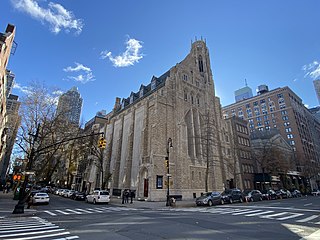
Central Presbyterian Church is a historic congregation on the Upper East Side of Manhattan in New York City, founded by pastor and abolitionist William Patton in 1821. It is a member of the Evangelical Presbyterian Church, and it worships in a Gothic Revival structure completed in 1922 that was originally commissioned and largely funded by John D. Rockefeller, Jr. as Park Avenue Baptist Church.

Westminster Presbyterian Church is in the Jefferson Park neighborhood of Los Angeles, California. Westminster Presbyterian Church is a member of the Presbyterian Church (U.S.A.), the Synod of Southern California and Hawaii and Pacific Presbytery. The congregation, established in 1904, is one of the oldest African American Presbyterian churches in California and west of the Mississippi River.





















